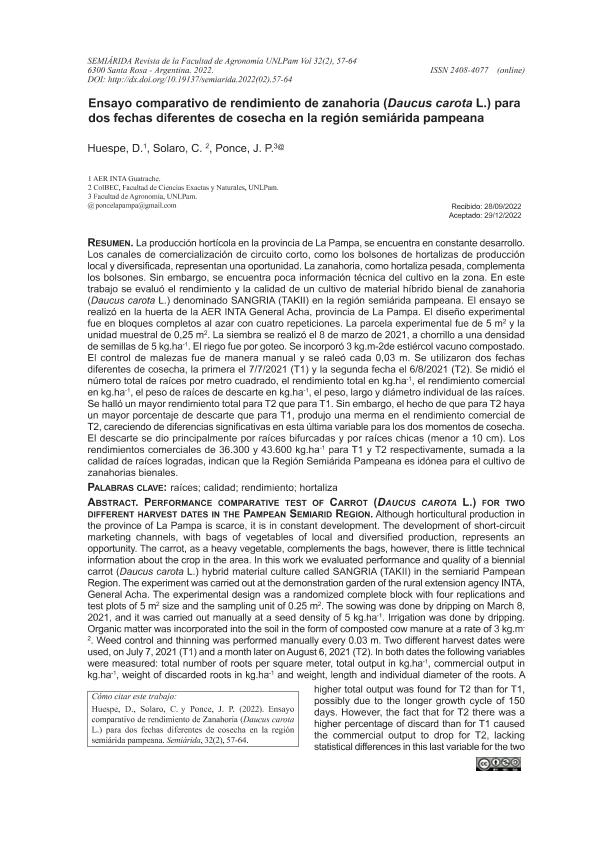Mostrar el registro sencillo del ítem
dc.contributor.author
Huespe, Daiana Susana

dc.contributor.author
Solaro, Claudina

dc.contributor.author
Ponce, Juan Pablo

dc.date.available
2024-04-12T11:58:11Z
dc.date.issued
2023-05
dc.identifier.citation
Huespe, Daiana Susana; Solaro, Claudina; Ponce, Juan Pablo; Ensayo comparativo de rendimiento de zanahoria (Daucus carota L.) para dos fechas diferentes de cosecha en la región semiárida pampeana; Universidad nacional de La Pampa. Facultad de Agronomía; Semiárida; 32; 2; 5-2023; 57-64
dc.identifier.issn
2362-4337
dc.identifier.uri
http://hdl.handle.net/11336/232851
dc.description.abstract
La producción hortícola en la provincia de La Pampa, se encuentra en constante desarrollo.Los canales de comercialización de circuito corto, como los bolsones de hortalizas de producciónlocal y diversificada, representan una oportunidad. La zanahoria, como hortaliza pesada, complementa los bolsones. Sin embargo, se encuentra poca información técnica del cultivo en la zona. En este trabajo se evaluó el rendimiento y la calidad de un cultivo de material híbrido bienal de zanahoria (Daucus carota L.) denominado SANGRIA (TAKII) en la región semiárida pampeana. El ensayo se realizó en la huerta de la AER INTA General Acha, provincia de La Pampa. El diseño experimental fue en bloques completos al azar con cuatro repeticiones. La parcela experimental fue de 5 m2 y la unidad muestral de 0,25 m2. La siembra se realizó el 8 de marzo de 2021, a chorrillo a una densidad de semillas de 5 kg.ha-1. El riego fue por goteo. Se incorporó 3 kg.m-2de estiércol vacuno compostado. El control de malezas fue de manera manual y se raleó cada 0,03 m. Se utilizaron dos fechas diferentes de cosecha, la primera el 7/7/2021 (T1) y la segunda fecha el 6/8/2021 (T2). Se midió el número total de raíces por metro cuadrado, el rendimiento total en kg.ha-1, el rendimiento comercial en kg.ha-1, el peso de raíces de descarte en kg.ha-1, el peso, largo y diámetro individual de las raíces. Se halló un mayor rendimiento total para T2 que para T1. Sin embargo, el hecho de que para T2 haya un mayor porcentaje de descarte que para T1, produjo una merma en el rendimiento comercial de T2, careciendo de diferencias significativas en esta última variable para los dos momentos de cosecha. El descarte se dio principalmente por raíces bifurcadas y por raíces chicas (menor a 10 cm). Los rendimientos comerciales de 36.300 y 43.600 kg.ha-1 para T1 y T2 respectivamente, sumada a la calidad de raíces logradas, indican que la Región Semiárida Pampeana es idónea para el cultivo de zanahorias bienales.
dc.description.abstract
Although horticultural production in the province of La Pampa is scarce, it is in constant development. The development of short-circuit marketing channels, with bags of vegetables of local and diversified production, represents an opportunity. The carrot, as a heavy vegetable, complements the bags, however, there is little technical information about the crop in the area. In this work we evaluated performance and quality of a biennial carrot (Daucus carota L.) hybrid material culture called SANGRIA (TAKII) in the semiarid Pampean Region. The experiment was carried out at the demonstration garden of the rural extension agency INTA, General Acha. The experimental design was a randomized complete block with four replications and test plots of 5 m2 size and the sampling unit of 0.25 m2 . The sowing was done by dripping on March 8, 2021, and it was carried out manually at a seed density of 5 kg.ha-1. Irrigation was done by dripping. Organic matter was incorporated into the soil in the form of composted cow manure at a rate of 3 kg.m2 . Weed control and thinning was performed manually every 0.03 m. Two different harvest dates were used, on July 7, 2021 (T1) and a month later on August 6, 2021 (T2). In both dates the following variables were measured: total number of roots per square meter, total output in kg.ha-1, commercial output in kg.ha-1, weight of discarded roots in kg.ha-1 and weight, length and individual diameter of the roots. A higher total output was found for T2 than for T1, possibly due to the longer growth cycle of 150 days. However, the fact that for T2 there was a higher percentage of discard than for T1 caused the commercial output to drop for T2, lacking statistical differences in this last variable for the two harvest moments. Discard was mainly due to either bifurcated roots or small roots (less than 10 cm). The commercial yields of 36300 and 43600 kg.ha-1 for T1 and T2 respectively, indicate that the Pampean Semi-Arid Region is ideal for the cultivation of biennial carrots added to the quality of roots achieved.
dc.format
application/pdf
dc.language.iso
spa
dc.publisher
Universidad nacional de La Pampa. Facultad de Agronomía
dc.rights
info:eu-repo/semantics/openAccess
dc.rights.uri
https://creativecommons.org/licenses/by-nc-sa/2.5/ar/
dc.subject
raíces
dc.subject
calidad
dc.subject
rendimiento
dc.subject
hortaliza
dc.subject.classification
Horticultura, Viticultura

dc.subject.classification
Agricultura, Silvicultura y Pesca

dc.subject.classification
CIENCIAS AGRÍCOLAS

dc.title
Ensayo comparativo de rendimiento de zanahoria (Daucus carota L.) para dos fechas diferentes de cosecha en la región semiárida pampeana
dc.type
info:eu-repo/semantics/article
dc.type
info:ar-repo/semantics/artículo
dc.type
info:eu-repo/semantics/publishedVersion
dc.date.updated
2024-04-09T12:08:27Z
dc.identifier.eissn
2408-4077
dc.journal.volume
32
dc.journal.number
2
dc.journal.pagination
57-64
dc.journal.pais
Argentina

dc.journal.ciudad
Santa Rosa
dc.description.fil
Fil: Huespe, Daiana Susana. Instituto Nacional de Tecnología Agropecuaria; Argentina
dc.description.fil
Fil: Solaro, Claudina. Universidad Nacional de La Pampa. Facultad de Ciencias Exactas y Naturales; Argentina. Consejo Nacional de Investigaciones Científicas y Técnicas. Instituto de Ciencias de la Tierra y Ambientales de La Pampa. Universidad Nacional de La Pampa. Facultad de Ciencias Exactas y Naturales. Instituto de Ciencias de la Tierra y Ambientales de La Pampa; Argentina
dc.description.fil
Fil: Ponce, Juan Pablo. Universidad Nacional de La Pampa. Facultad de Agronomía; Argentina
dc.journal.title
Semiárida
dc.relation.alternativeid
info:eu-repo/semantics/altIdentifier/url/https://cerac.unlpam.edu.ar/index.php/semiarida/article/view/semiarida.2022%2802%29.57-64
dc.relation.alternativeid
info:eu-repo/semantics/altIdentifier/doi/http://dx.doi.org/10.19137/semiarida.2022(02).57-64
Archivos asociados
